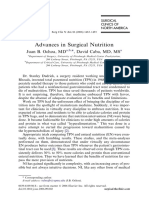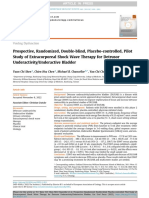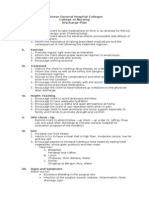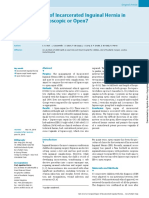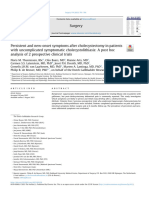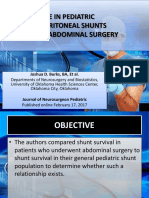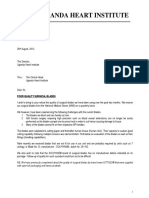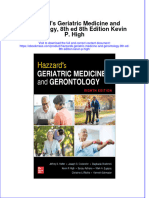A Myth About Anastomotic Leak
A Myth About Anastomotic Leak
Uploaded by
Avinash RoyCopyright:
Available Formats
A Myth About Anastomotic Leak
A Myth About Anastomotic Leak
Uploaded by
Avinash RoyCopyright
Available Formats
Share this document
Did you find this document useful?
Is this content inappropriate?
Copyright:
Available Formats
A Myth About Anastomotic Leak
A Myth About Anastomotic Leak
Uploaded by
Avinash RoyCopyright:
Available Formats
International Surgery Journal
Shakya P et al. Int Surg J. 2016 Feb;3(1):81-83
http://www.ijsurgery.com
pISSN 2349-3305 | eISSN 2349-2902
DOI: http://dx.doi.org/10.18203/2349-2902.isj20151490
Research Article
A myth that early feeding causes bowel anastomotic leakage: is it true?
Prateek Shakya*, Bhuvan C.
Department of General Surgery, Government Medical College, Haldwani, Uttarakhand, India
Received: 01 December 2015
Revised: 02 December 2015
Accepted: 08 December 2015
*Correspondence:
Dr. Prateek Shakya,
E-mail: drprateekshakya@gmail.com
Copyright: the author(s), publisher and licensee Medip Academy. This is an open-access article distributed under
the terms of the Creative Commons Attribution Non-Commercial License, which permits unrestricted non-commercial
use, distribution, and reproduction in any medium, provided the original work is properly cited.
ABSTRACT
Background: Traditionally its believed that long fasting after intestinal surgery protect anastomosis site. However
delayed feeding causes mental stress on patients, any beneficial effect of delayed feeding is yet to be proved. Early
feeding should be promoted as longer fasting cause mucosal atrophy of the intestine and fasting patients requires TPN
that has its own problems and complications along with additional costs.
Methods: The aim of study is to evaluate the outcomes of early feeding in bowel anastomosis in terms of intestinal
anastmotic leakage, post operative ileus and hospital stay. We included 100 patients of age group 20-50 yrs who
underwent ileostomy closure and they were randomized blindly into two groups - early vs. late feeding group.
Results: The mean time of first oral normal feed in early feeding group was 2.29 0.37 as compared to delayed
feeding group which was 6.44 0.43 days (p value significant <0.0001). The first defecation was significantly earlier
in the study group as compared to late feeding group (study group mean 4.04 0.21 vs. control group mean 7.9 0.22,
p value <0.0001) and hospital stay is significantly shorter in study group (early group mean 4 0.21 vs. delayed
feeding group 8.08 0.23, p value <0.0001) as compared to late feeding group. There was no mortality and
anastomotic leakage in both groups.
Conclusions: Early feeding does not cause any major complication i.e. anastomotic leakage and promotes overall
patients feeling of wellbeing and decrease hospital stay and costs.
Keywords: Early feeding, Delayed feeding, Anastomotic leakage
INTRODUCTION
In the past around 18th or 19th century there was a concept
of delayed oral feeding only after passage of flatus or
stool. This management has been adopted over the years
with the notion that restriction of oral feeding gives the
GI tract more time to heal & recover & reduces stress on
anastomosis site and prevent leakage thus reducing post
operative complications,1 but even if we do not give oral
feeding, about 2-2.5 L of gastrointestinal and pancreatic
secretions enters the small bowel and transit from the
anastomosis site, thus feeding has no additional adverse
effects on anastomosis site. Early feeding delays post
operative ileus, helps in wound healing and reduction of
sepsis.2 Post operative ileus had been an important reason
for patients kept NPO in post operative period However
after surgery the return of bowel function and motility
occurs within 6-12 hr in small bowel, 12-24 hr in
stomach and within 48-72 hr in large bowel.3 Post
operative starvation changes the metabolism of the body
within 24 hours by increasing insulin resistance and
reducing muscle function.2
The purpose of this study is to evaluate that early feeding
is having any additional advantage over the traditional
feeding in terms of post operative ileus, bowel
anastomosis leakage and hospital stay.
International Surgery Journal | January-March 2016 | Vol 3 | Issue 1
Page 81
Shakya P et al. Int Surg J. 2016 Feb;3(1):81-83
in any patient we had not reinserted the nasogastric
feeding tube.
METHODS
A total of One hundred (100) patients who underwent
ileostomy closure in surgical department of Government
medical college Haldwani were included in the study who
were randomized blindly into two groups- early feeding
(study group) vs. late feeding (control group). The
patients of age group 20 yrs to 50 yrs were included in
the study and the patients who were not fit for the surgery
were excluded from the study. All the operations were
performed by single unit of general surgery with same
technique- extra mucosal interrupted single layer bowel
anastomosis using either vicryl 3-0 or 2-0 RB. Pre
operative bowel preparation was same for both groups
and in the post operative period patient was given same
antibiotics and same analgesia. In all the cases
nasogastric tube was removed after 6 hrs of post
operative period. In early feeding groups we started the
feeding after 12-24 hrs of surgery with clear water at the
rate of 50ml/hr well tolerated patients were taken on semi
solid diet after 24- 36 hrs and on normal regular diet after
36 - 48 hr of surgery. Those patients who were not
tolerating had abdominal distention and vomiting feeding
was stop for 12 hrs and refeeding was started afterwards.
In late feeding groups we started the feeding in a
traditional method (after bowel sounds and passage of
flatus) after 5 days and same feeding plan was given in
early feeding group. Patient general vital charting (pulse
rate, blood pressure, fever), assessment of time of
passage of first stool, appearance of bowel sounds and
assessment of complaints like vomiting, abdominal
distension and signs of bowel anastomosis dehiscence
(fever, tachycardia, abdominal distension, guarding,
rigidity, drain content and output) were done at every 12
hourly. All complications were recorded. To compare
specific variables, t-test and Chi-square tests were used.
In all statistical analysis, a p value of <0.05 was
considered statistically significant.
RESULTS
The early feeding group included 28 males & 22 females
with a mean age of 35.6 7.8.whereas late feeding group
consist of 33 males & 17 females with a mean age of
35.4 8.77 there was no significant difference in terms of
genders or age of the patients as shown in Table 1. The
mean time of first oral normal feed was 2.29 0.37 days
in early feeding group and 6.44 0.43 days in late feeding
group that was significantly shorter (p value <0.0001) in
early feeding group. In early feeding group passage of
stool occur significantly earlier 4.04 0.21 days versus
7.9 0.22 days; p value <0.0001, in late feeding group.
Hospital stay in early feeding group is significantly
shorter (4.9 0.33 days; p value <0.0001) as compared to
late feeding group (8.08 0.233). All the result is
summarized in Table 2. No anastomosis leakage and
mortality is noted in both the groups. None of the patients
had symptoms of vomiting and abdominal distention and
Table 1: The demographic data in study groups.
Patients
group
Early
feeding
N=50
Late
feeding
N=50
P value
Age in
years
35.6 7.8
32 4.8
<0.253
Sex
28 (male)
22 (female)
33 (male)
17 (female)
<0.305
Table 2: Comparative result of two groups early vs.
late feeding groups.
Patient group
Initial normal
oral feed days
First defecation
after surgery
Hospital stay
Anastomotic
leakage
Early
feeding
N=50
Late
feeding
N=50
P value
2.29 0.37
6.44 0.43
<0.0001
4.04 0.21
7.9 0.22
<0.0001
4.9 0.33
8.08 0.23
<0.0001
DISCUSSION
The concept that early feeding causes anastomotic
leakage is not true, it has been clearly demonstrated that
mucosal epithelium of the bowel is perfectly sealed after
the first 24 hrs of the post operative period 4 and in our
study we started the feeding at 12-24 hrs and no leakage
is demonstrated. It has been also shown that early feeding
accelerates the wound and anastomosis healing in the
animal model.5 Early feeding reverses the mucosal
atrophy induced by starvation and increases anastomotic
collagen deposition and strength.6-8
Most of the practicing surgeon even today practicing,
keep the patient NPO for 4-5 days after ileostomy closure
and uses nasogastric tubes until resolution of the post
operative ileus .Recently ,this approach has been
questioned and few studies have shown that nasogastric
tube insertion has a limited role in postoperative care of
abdominal surgery.2 In present study ,nasogastric tube
was inserted before surgery and removed after 6 hr of
surgery and this approach was tolerated by all the patients
and in no patients we needed reinsertion of nasogastric
tube.
Early feeding decreases the incidence of postoperative
ileus by stimulating the reflex that produces co ordinate
propulsive activity and elicits the secretion of GI
hormones thus shortening the duration of post operative
ileus instead of causing it.9 In present study, patient of
study group has first defecation
much earlier as
compared to late feeding group.
International Surgery Journal | January-March 2016 | Vol 3 | Issue 1
Page 82
Shakya P et al. Int Surg J. 2016 Feb;3(1):81-83
Oral fluid and food intake following surgery improved
the sense of wellbeing.10 In addition early feeding leads
to earlier discharge from the hospital11 and also decreases
the incidence of nosocomial infections, liver dysfunction,
bacterial translocation and secondary malnutrition.4,12
In our study hospital stay of the patient is significantly
low in early feeding group has compared to study group.
CONCLUSION
This study showed that the early feeding after ileostomy
closure is a safe method that improves the condition of
the patients without increasing the post-operative
complications and this increases parents and patients
satisfaction. This approach reduces hospital cost and stay
also.
ACKNOWLEDGMENTS
We are grateful to our patients and their parents for
participation in our study.
Funding: No funding sources
Conflict of interest: None declared
Ethical approval: The study was approved by the
institutional ethics committee
REFERENCES
1.
2.
3.
Zhuang CL, Ye XZ, Zhang JC, Dong QT, Chen BC,
Yu Z. Early versus Traditional Postoperative Oral
Feeding in Patients Undergoing Elective Colorectal
Surgery: A Meta-Analysis of Randomized Clinical
Trials Dig Surg. 2013;30:22532.
Dag A, Colak T, Turkmenoglu O, Gundogdu R,
Aydin S. A randomized controlled trial evaluating
early vs traditional oral feeding after colorectal
surgery. Clinics (Sao Paulo). 2011;66:2001-5.
Amanollahi O, Azizi B. The comparative study of
the outcomesof early and late oral feeding in
intestinal anastomosis surgeries in children African
Journal of Paediatric Surgery. 2013;10(2);74-77.
4.
Stewart BT, Woods RJ, Collopy BT, Fink RJ,
Mackay JR, Keck JO. Early Feeding after Elective
Open Colorectal Resections: A Prospective
Randomized Trial. Australian and New Zealand
Journal of Surgery. 1998;68,2:125-8.
5. Gokpinar I, Gurleyik E, Pehlivan M, Ozcan O,
Ozaydin I, Aslaner A. Early Enteral and Glutamine
Enriched Enteral Feeding Ameliorates Healing of
Colonic Anastomosis: Experi-mental Study. Ulusal
Travma ve Acil Cerrahi Dergisi. 2006;12,1;17-21.
6. Ozerhan IH, Ersoz N, Onguru O, Ozturk M, Kurt B,
Cetiner S. Fascin expression in colorectal
carcinomas. Clinics. 2010;65:15764.
7. Gonalves CG, Groth AK, Ferreira M, Matias JE,
Coelho JC, Campos AC. Influence of preoperative
feeding on the healing of colonic anastomoses in
malnourished rats. J Parenter Enteral Nutr.
2009;33:839.
8. Filiz AI, Sucullu I, Kurt Y, Karakas DO, Gulec B,
Akin
ML.
Persistent
high
postoperative
carcinoembryonic antigen in colorectal cancer
patientsis it important. Clinics. 2009;64:28794.
9. Anderson ADG, McNaught, MacFie CE, Tring J,
Barker I. Randomized clinical trial of multimodal
optimization and standard preoperative surgical
care. British Journal of Surgery. 2003;90:1497504.
10. Schilder JM, Hurteau JA, Look KY, Moore DH,
Raff G, Stehman FB. A prospective controlled trial
of early postoperative oral intake following major
abdominal gynecologic surgery. Gynecol Oncol.
1997;67:235.
11. Steed HL, Capstick V, Flood C, Schepansky A,
Schulz J, Mayes DC. A randomized controlled trial
of early versus traditional' postoperative oral intake
after major abdominal gynecologic surgery. Am J
Obstet Gynecol. 2002;186:8615.
12. Han-Geurts IJ, Hop WCJ, Kok NFM. Randomized
Clinical Trial of the Impact of Early Enteral Feeding
on Postoperative Ileus and Recovery, British
Journal of Surgery. 2007;94(5):555-61.
Cite this article as: Shakya P, Bhuvan C. A myth
that early feeding causes bowel anastomotic
leakage: is it true? Int Surg J 2016;3:81-3.
International Surgery Journal | January-March 2016 | Vol 3 | Issue 1
Page 83
You might also like
- Postoperative Oral Feeding After Cesarean Section-Early Versus Late Initiation: A Prospective Randomized TrialDocument5 pagesPostoperative Oral Feeding After Cesarean Section-Early Versus Late Initiation: A Prospective Randomized Trialjustin_saneNo ratings yet
- Pattern of Acute Intestinal Obstruction: Is There A Change in The Underlying Etiology?Document4 pagesPattern of Acute Intestinal Obstruction: Is There A Change in The Underlying Etiology?neildamiNo ratings yet
- The Effect of Nursing Intervention of Postoperative Thirst in Patients After Laparoscopic CholecystectomyDocument3 pagesThe Effect of Nursing Intervention of Postoperative Thirst in Patients After Laparoscopic CholecystectomySHUMETNo ratings yet
- Fast-Track Recovery Programme After Pancreatico-Duodenectomy Reduces Delayed Gastric EmptyingDocument7 pagesFast-Track Recovery Programme After Pancreatico-Duodenectomy Reduces Delayed Gastric EmptyinghoangducnamNo ratings yet
- Periop UrologyKoubaartikelDocument4 pagesPeriop UrologyKoubaartikeljustin_saneNo ratings yet
- Bmri2017 6543014Document4 pagesBmri2017 6543014Andrea TamayoNo ratings yet
- 10 Early FeedingDocument6 pages10 Early FeedingIyah EstacioNo ratings yet
- Early enteral nutritionDocument6 pagesEarly enteral nutritionMyat Htut Ko KoNo ratings yet
- Bristol Stool ChartDocument5 pagesBristol Stool ChartlguerreroNo ratings yet
- Gum Chewing SurgeryDocument3 pagesGum Chewing SurgeryTony YuliantoNo ratings yet
- Research ArticleDocument7 pagesResearch ArticlePrincess Angie GonzalesNo ratings yet
- Ne en WhippleDocument9 pagesNe en WhippleOscar VillacresNo ratings yet
- Perioperative Fasting: A Time To Relook: Guest EditorialDocument2 pagesPerioperative Fasting: A Time To Relook: Guest EditorialIbraim CervantesNo ratings yet
- Early Enteral Feeding Versus Traditional Feeding in Neonate Congenital GI Malformation Undergoing Intestinal AnastomosisDocument6 pagesEarly Enteral Feeding Versus Traditional Feeding in Neonate Congenital GI Malformation Undergoing Intestinal AnastomosisWendy LiNo ratings yet
- The Effects of Abdominal I LOV U Massage Along With Lifestyle Training On Constipation and Distension in The Elderly With StrokeDocument9 pagesThe Effects of Abdominal I LOV U Massage Along With Lifestyle Training On Constipation and Distension in The Elderly With StrokeSuci NudiNo ratings yet
- Ebp Presentation 1Document21 pagesEbp Presentation 1api-340248301No ratings yet
- Advances in Surgical NutritionDocument11 pagesAdvances in Surgical NutritionOtto Guillermo SontayNo ratings yet
- Duration of Fasting During Acute Variceal BleedingDocument4 pagesDuration of Fasting During Acute Variceal Bleedingannisa edwarNo ratings yet
- 129Document9 pages129Venkatesh UNo ratings yet
- 3 The Effect of EarlyDocument8 pages3 The Effect of EarlydipanajnNo ratings yet
- Multicentre, Cluster-Randomized Clinical Trial of Algorithms For Critical-Care Enteral and Parenteral Therapy (ACCEPT)Document8 pagesMulticentre, Cluster-Randomized Clinical Trial of Algorithms For Critical-Care Enteral and Parenteral Therapy (ACCEPT)eryxspNo ratings yet
- WJS GastrografinDocument12 pagesWJS Gastrografinkelly_ann23No ratings yet
- Early Oral Intakes After Minimally Invasive Esophagectomy in Esophageal Cancer PatientsDocument9 pagesEarly Oral Intakes After Minimally Invasive Esophagectomy in Esophageal Cancer Patientsaudrey.r.bedwellNo ratings yet
- 512 FullDocument10 pages512 FullCriyz Dwi KristinaNo ratings yet
- Hydrostatic Reduction of Intussusception in Children - A Single Centre ExperienceDocument9 pagesHydrostatic Reduction of Intussusception in Children - A Single Centre ExperienceMostafa MosbehNo ratings yet
- A Double Blind, Randomised, Placebo-Controlled Trial of Lactobacillus Acute Watery Diarrhoea in Vietnamese ChildrenDocument26 pagesA Double Blind, Randomised, Placebo-Controlled Trial of Lactobacillus Acute Watery Diarrhoea in Vietnamese ChildrenSeftiyantiNo ratings yet
- CASE STUDIES L3 A Group 3Document10 pagesCASE STUDIES L3 A Group 3Doneva Lyn MedinaNo ratings yet
- Simple Steps To Hasten Postoperative Recovery 2167 0420.1000137Document3 pagesSimple Steps To Hasten Postoperative Recovery 2167 0420.1000137Ibnu SyahNo ratings yet
- Stopping or Reducing Dietary Fiber Intake Reduces ConstipationDocument4 pagesStopping or Reducing Dietary Fiber Intake Reduces ConstipationleonardopinheiroNo ratings yet
- 72-Article Text-280-2-10-20200328Document6 pages72-Article Text-280-2-10-20200328Fikri RamadhanNo ratings yet
- Gastric Versus Postpyloric Enteral Nutrition in Elderly Patients (Age 75 Years) On Mechanical Ventilation: A Single-Center Randomized TrialDocument11 pagesGastric Versus Postpyloric Enteral Nutrition in Elderly Patients (Age 75 Years) On Mechanical Ventilation: A Single-Center Randomized TrialDyana NurNo ratings yet
- Gum Chewing Stimulates Early Return of Bowel Motility After Caesarean SectionDocument6 pagesGum Chewing Stimulates Early Return of Bowel Motility After Caesarean Sectionstepharry08No ratings yet
- PIIS2405456922002619Document7 pagesPIIS2405456922002619Oriol Colet GuitertNo ratings yet
- Aliment Pharmacol Ther - 2006 - YAMAMOTO - Impact of Long Term Enteral Nutrition On Clinical and Endoscopic RecurrenceDocument6 pagesAliment Pharmacol Ther - 2006 - YAMAMOTO - Impact of Long Term Enteral Nutrition On Clinical and Endoscopic Recurrencerina.emadnagy111No ratings yet
- CreonDocument12 pagesCreonNikola StojsicNo ratings yet
- Evaluation of Gastric Emptying by Ultrasonography after Recommended Fasting Period and Administration of Prokinetic in End-stage Renal Disease Patients - PMCDocument12 pagesEvaluation of Gastric Emptying by Ultrasonography after Recommended Fasting Period and Administration of Prokinetic in End-stage Renal Disease Patients - PMCyhanwatt.everNo ratings yet
- Can Postoperative Nutrition Be Favourably Maintained by Oral Diet in Patients With Emergency Temporary Ileostomy? A Tertiary Hospital Based StudyDocument5 pagesCan Postoperative Nutrition Be Favourably Maintained by Oral Diet in Patients With Emergency Temporary Ileostomy? A Tertiary Hospital Based StudydwirizqillahNo ratings yet
- Pre-Op NPO and Traditional Post-Op Diet Advancement: Time To Move OnDocument7 pagesPre-Op NPO and Traditional Post-Op Diet Advancement: Time To Move OnDaru KristiyonoNo ratings yet
- Small Bowel Emergency Surgery Literatures ReviewDocument6 pagesSmall Bowel Emergency Surgery Literatures Reviewc5pbp8dkNo ratings yet
- Top Trials in Gastroenterology & HepatologyFrom EverandTop Trials in Gastroenterology & HepatologyRating: 4.5 out of 5 stars4.5/5 (7)
- Clinical Study of Bowel ObstructionDocument6 pagesClinical Study of Bowel ObstructionhorzhanNo ratings yet
- Early Traditional Postoperative Feeding Practices Following Gastrointestinal Surgery: A Meta-AnalysisDocument45 pagesEarly Traditional Postoperative Feeding Practices Following Gastrointestinal Surgery: A Meta-Analysisjustin_saneNo ratings yet
- Early Feeding After Digestive Surgery Is 43f243f3Document4 pagesEarly Feeding After Digestive Surgery Is 43f243f3sarahsamaliaNo ratings yet
- Chinese General Hospital Colleges College of Nursing Discharge PlanDocument4 pagesChinese General Hospital Colleges College of Nursing Discharge PlanTin BernardezNo ratings yet
- Multicenter, Randomized, Controlled Trial of Heat-Killed Lactobacillus Acidophilus LB in Patients With Chronic Diarrhea Adv The 2003Document8 pagesMulticenter, Randomized, Controlled Trial of Heat-Killed Lactobacillus Acidophilus LB in Patients With Chronic Diarrhea Adv The 2003lalocerdaNo ratings yet
- JPEN24 - GI-US in the critically illDocument11 pagesJPEN24 - GI-US in the critically illLeonardo ChacónNo ratings yet
- Protexin Restore StudyDocument13 pagesProtexin Restore StudyAsif GhafoorNo ratings yet
- Bacillus Clausii As An Adjuvant Therapy in Acute Childhood DiarrhoeaDocument3 pagesBacillus Clausii As An Adjuvant Therapy in Acute Childhood DiarrhoeaIOSRjournalNo ratings yet
- Nah Incarcerated HerniaDocument4 pagesNah Incarcerated Herniafelix_the_meowNo ratings yet
- Delayed gastric emptying in nondiabetic patients with end-stage kidney disease (1)Document8 pagesDelayed gastric emptying in nondiabetic patients with end-stage kidney disease (1)yhanwatt.everNo ratings yet
- 1-s2.0-S0002916522000636-mainDocument10 pages1-s2.0-S0002916522000636-mainfaramonapramadhan12No ratings yet
- Colecistectomia - Colelitíase - Sintomas PO, Surgery, v.174, n.4, Oct. 2023.Document6 pagesColecistectomia - Colelitíase - Sintomas PO, Surgery, v.174, n.4, Oct. 2023.Thiago FreireNo ratings yet
- Preoperative Fasting GuidelinesDocument4 pagesPreoperative Fasting GuidelinesLuis Alberto BuendiaNo ratings yet
- Gastric Versus Jejunal Feeding: Evidence or Emotion?: Nutrition Issues in Gastroenterology, Series #42Document11 pagesGastric Versus Jejunal Feeding: Evidence or Emotion?: Nutrition Issues in Gastroenterology, Series #42Giselle Pezoa WattsonNo ratings yet
- The American Journal of Surgery: Conor Holland, Lynn Shaffer, Elliot Dobkin, Jamie HallDocument5 pagesThe American Journal of Surgery: Conor Holland, Lynn Shaffer, Elliot Dobkin, Jamie HallDelvin GómezNo ratings yet
- A C Term 3 Concept Map FinalDocument12 pagesA C Term 3 Concept Map FinalAmanda CeresaNo ratings yet
- Simple Steps To Hasten Post-Operative RecoveryDocument3 pagesSimple Steps To Hasten Post-Operative Recoveryanggaarfina051821No ratings yet
- Risk of Failure in Pediatric Ventriculoperitoneal Shunts Placed After Abdominal SurgeryDocument31 pagesRisk of Failure in Pediatric Ventriculoperitoneal Shunts Placed After Abdominal SurgeryWielda VeramitaNo ratings yet
- Nutritional Support after Gastrointestinal SurgeryFrom EverandNutritional Support after Gastrointestinal SurgeryDonato Francesco AltomareNo ratings yet
- Operation - SurgeryDocument17 pagesOperation - SurgeryKarl RobleNo ratings yet
- Narayana Hurdyalaya Business Model CanvasDocument7 pagesNarayana Hurdyalaya Business Model CanvasShubham SinhaNo ratings yet
- Endodontic Diagnostic Terminology UpdateDocument3 pagesEndodontic Diagnostic Terminology UpdateAlyaefkageNo ratings yet
- AMA School of Medicine: Marcos Highway Brgy. Mayamot, Antipolo City, RizalDocument3 pagesAMA School of Medicine: Marcos Highway Brgy. Mayamot, Antipolo City, RizalApril KramerNo ratings yet
- Cmca Lec ReviewerDocument32 pagesCmca Lec Reviewercuteathena11No ratings yet
- Poor Quality of Surgical BladesDocument2 pagesPoor Quality of Surgical BladesBenard OyangNo ratings yet
- Health Problems Should MustDocument1 pageHealth Problems Should MusttobilanderNo ratings yet
- FANA President Dr. Jorge Valdes To Participate in Upcoming Florida Health Care Affordability SummitDocument1 pageFANA President Dr. Jorge Valdes To Participate in Upcoming Florida Health Care Affordability Summitapi-157539785No ratings yet
- SurvivorshipDocument263 pagesSurvivorshipLuis SosaNo ratings yet
- Guidelines For CHPS ImplementationDocument16 pagesGuidelines For CHPS ImplementationErasmus Agongo100% (1)
- Second Announcement SOAC 2024-1Document24 pagesSecond Announcement SOAC 2024-1Oktiya SariNo ratings yet
- Open Prostatectomy For Huge Prostates Our Experience in A Developing Country 2329 9088.1000132Document3 pagesOpen Prostatectomy For Huge Prostates Our Experience in A Developing Country 2329 9088.1000132Ahmed Ben BellaNo ratings yet
- Stroke Inclusion Exclusion StrokeDocument1 pageStroke Inclusion Exclusion Strokecdeepak71No ratings yet
- Hospital DataDocument53 pagesHospital DataTheProject Prayer Rope0% (1)
- Prasuti Roga 2 Partttt RjniDocument96 pagesPrasuti Roga 2 Partttt RjniShazia NaazNo ratings yet
- Solution To Tutorial 2: ST3241 Categorical Data Analysis I Semester II, 2010-2011Document4 pagesSolution To Tutorial 2: ST3241 Categorical Data Analysis I Semester II, 2010-2011Griya AyuNo ratings yet
- Pharmaceutical Benefits Under State Medical Assistance Programs, 2007Document610 pagesPharmaceutical Benefits Under State Medical Assistance Programs, 2007National Pharmaceutical Council100% (3)
- 7 Postpartum CareDocument20 pages7 Postpartum CareVirgie GigiNo ratings yet
- Symptoms Respiratory System Cardiovascular System DiagnosisDocument2 pagesSymptoms Respiratory System Cardiovascular System DiagnosisAdelina RinataNo ratings yet
- Philippine National Demographic and Health Survey 2017 - NewDocument430 pagesPhilippine National Demographic and Health Survey 2017 - NewRudy LangiNo ratings yet
- Hazzard's Geriatric Medicine and Gerontology, 8th Ed 8th Edition Kevin P. High Full Chapter Instant DownloadDocument54 pagesHazzard's Geriatric Medicine and Gerontology, 8th Ed 8th Edition Kevin P. High Full Chapter Instant Downloadrhineypeuna100% (4)
- Summary 100bedded Hospital CancerDocument3 pagesSummary 100bedded Hospital CancerDarshit JoshiNo ratings yet
- Pedia Form Sample (Alpha)Document3 pagesPedia Form Sample (Alpha)Rj PolvorosaNo ratings yet
- Massive Transfusion Protocol-BbhDocument17 pagesMassive Transfusion Protocol-Bbhkrgdurai100% (3)
- Massachusetts General Hospital (MGH) History: The CABG Surgical ProcedureDocument3 pagesMassachusetts General Hospital (MGH) History: The CABG Surgical ProcedureAlok RajNo ratings yet
- Ten Rules For The Management of Moderate and Severe Traumatic Brain Injury During Pregnancy: An Expert ViewpointDocument11 pagesTen Rules For The Management of Moderate and Severe Traumatic Brain Injury During Pregnancy: An Expert ViewpointKaren Campos GonzalezNo ratings yet
- Multiple Choice Questions: Childhood Obesity and The AnaesthetistDocument5 pagesMultiple Choice Questions: Childhood Obesity and The AnaesthetistTanishka GargNo ratings yet
- A Study To Assess The Effectiveness of Structured Teaching Programme in Knowledge and PRactice of Menstrual Hygiene Among Adolescent Girls in Selected School at BidarDocument21 pagesA Study To Assess The Effectiveness of Structured Teaching Programme in Knowledge and PRactice of Menstrual Hygiene Among Adolescent Girls in Selected School at BidarOwais Khan100% (2)
- Daftar Rotasi Petugas Dilingkungan Rsud CideresDocument4 pagesDaftar Rotasi Petugas Dilingkungan Rsud Cidereswulan dariNo ratings yet
- The Role of Hysteroscopic and Robot-Assisted Laparoscopic Myomectomy in The Setting of InfertilityDocument13 pagesThe Role of Hysteroscopic and Robot-Assisted Laparoscopic Myomectomy in The Setting of InfertilityMarco Julcamoro AsencioNo ratings yet
















